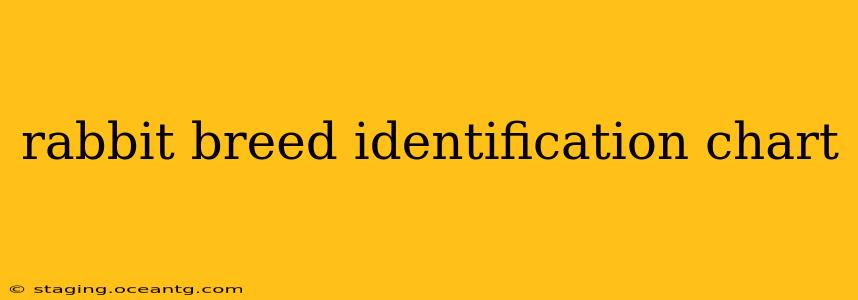Identifying rabbit breeds can be a fun and rewarding challenge, whether you're a seasoned breeder or a new rabbit owner. This comprehensive guide serves as your ultimate rabbit breed identification chart, going beyond a simple list to delve into key characteristics and help you accurately pinpoint your bunny's breed.
While a picture is often worth a thousand words, relying solely on visuals can be misleading. Breed standards are detailed and nuanced, and subtle variations exist even within the same breed. This guide aims to provide the information you need to confidently identify your rabbit's breed, considering factors beyond just appearance.
What are the Key Features to Consider for Rabbit Breed Identification?
Accurate breed identification requires a holistic approach. Don't just focus on coat color; consider these key features:
- Body type: Is the rabbit compact and muscular, long and lanky, or somewhere in between? Body shape is a crucial indicator.
- Coat type: Is the coat short and smooth, long and flowing, or something more unique like angora or rex? Texture and length are vital clues.
- Ear type and size: Rabbit ears vary significantly in size, shape, and placement on the head. This is a strong distinguishing feature.
- Head shape: Some breeds have distinctive head shapes, such as Roman noses or broad heads.
- Size: Rabbit breeds vary greatly in size, from tiny dwarfs to large Flemish Giants.
- Color and markings: While color alone isn't definitive, it's a valuable factor when combined with other characteristics.
Popular Rabbit Breeds and Their Distinguishing Features
Let's explore some popular rabbit breeds and their unique characteristics:
1. Flemish Giant:
- Body type: Massive and muscular, the largest domestic rabbit breed.
- Coat type: Short and dense.
- Ear type and size: Large and floppy.
- Head shape: Broad head.
- Size: Can weigh over 15 pounds.
- Color and markings: Variety of colors.
2. Dutch Rabbit:
- Body type: Compact and muscular.
- Coat type: Short and dense.
- Ear type and size: Medium-sized, erect ears.
- Head shape: Rounded head.
- Size: Medium-sized.
- Color and markings: Distinctive markings with white on the face, chest, and feet.
3. Lionhead Rabbit:
- Body type: Small and compact.
- Coat type: Short coat with a distinctive mane around the head.
- Ear type and size: Small to medium-sized, erect ears.
- Head shape: Round head.
- Size: Small.
- Color and markings: Wide variety of colors.
4. Angora Rabbit:
- Body type: Varies depending on the type of angora.
- Coat type: Extremely long, fluffy coat.
- Ear type and size: Varies depending on the type of angora.
- Head shape: Varies depending on the type of angora.
- Size: Varies depending on the type of angora.
- Color and markings: Wide variety of colors.
5. Rex Rabbit:
- Body type: Compact and muscular.
- Coat type: Short, velvety coat.
- Ear type and size: Medium-sized, erect ears.
- Head shape: Rounded head.
- Size: Medium-sized.
- Color and markings: Variety of colors.
H2: How Can I Tell the Difference Between Similar Rabbit Breeds?
Determining the differences between similar breeds often comes down to subtle variations in body type, ear shape, and coat texture. For example, differentiating between a Dutch and a Netherland Dwarf involves careful attention to size and markings. The Dutch rabbit is significantly larger and has a more distinct pattern.
H2: Are there online resources to help me identify my rabbit's breed?
Yes, many online resources can assist in rabbit breed identification. Several websites dedicated to rabbit breeds provide detailed information and images. However, remember to consider the limitations of online identification, as images may not always accurately depict all characteristics.
H2: What if I can't identify my rabbit's breed?
If you're struggling to pinpoint your rabbit's breed, don't worry! Many rabbits are mixes of different breeds, resulting in unique combinations of characteristics. Enjoy your rabbit's individuality, and remember that breed isn't the sole determinant of a happy and healthy pet. Focus on providing excellent care, regardless of your bunny's exact lineage.
Conclusion:
While this guide provides a solid foundation for rabbit breed identification, remember that experience plays a crucial role. The more rabbits you observe, the better you’ll become at identifying breeds. Combine this guide with careful observation and a bit of research, and you'll be well on your way to becoming a rabbit breed identification expert!
